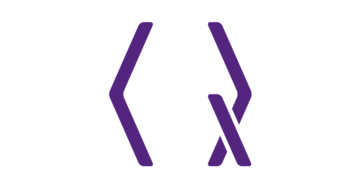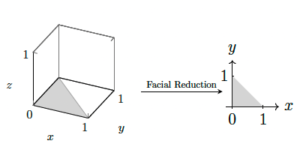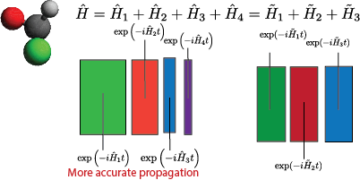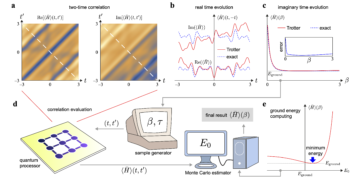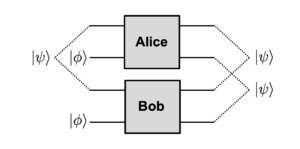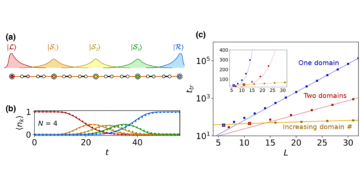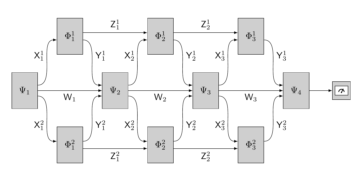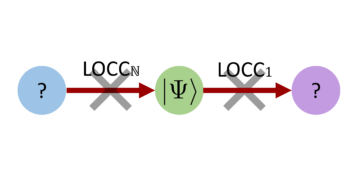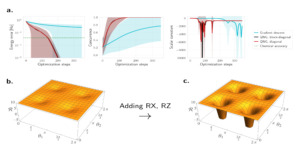1Department of Industrial and Operations Engineering, University of Michigan at Ann Arbor
2Joint Center for Quantum Information and Computer Science, NIST/University of Maryland
3Mathematics and Computer Science Division, Argonne National Laboratory
Find this paper interesting or want to discuss? Scite or leave a comment on SciRate.
Abstract
Quantum control aims to manipulate quantum systems toward specific quantum states or desired operations. Designing highly accurate and effective control steps is vitally important to various quantum applications, including energy minimization and circuit compilation. In this paper we focus on discrete binary quantum control problems and apply different optimization algorithms and techniques to improve computational efficiency and solution quality. Specifically, we develop a generic model and extend it in several ways. We introduce a squared $L_2$-penalty function to handle additional side constraints, to model requirements such as allowing at most one control to be active. We introduce a total variation (TV) regularizer to reduce the number of switches in the control. We modify the popular gradient ascent pulse engineering (GRAPE) algorithm, develop a new alternating direction method of multipliers (ADMM) algorithm to solve the continuous relaxation of the penalized model, and then apply rounding techniques to obtain binary control solutions. We propose a modified trust-region method to further improve the solutions. Our algorithms can obtain high-quality control results, as demonstrated by numerical studies on diverse quantum control examples.
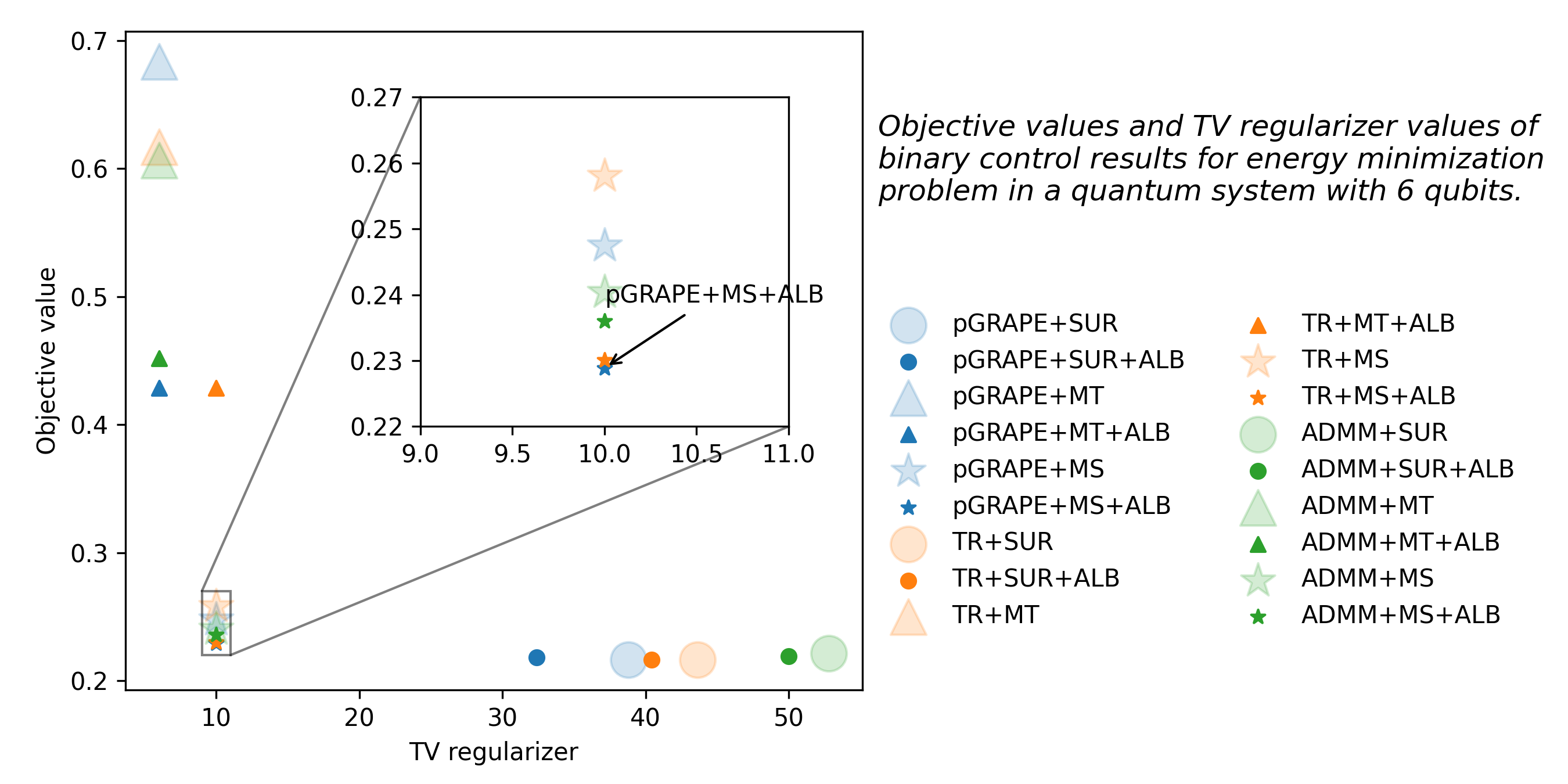
Featured image: Objective values and TV regularizer values of binary control results for energy minimization problem in a quantum system with 6 qubits.
Popular summary
efficiency and solution quality when solving quantum binary control problems.
These methods can be used for manipulating quantum systems towards specific
quantum states or desired operations, and are of vital importance to various
quantum applications, including energy minimization and circuit compilation.
► BibTeX data
► References
[1] Herschel Rabitz, Regina De Vivie-Riedle, Marcus Motzkus, and Karl Kompa. Whither the future of controlling quantum phenomena? Science, 288 (5467): 824–828, 2000. 10.1126/science.288.5467.824.
https://doi.org/10.1126/science.288.5467.824
[2] J. Werschnik and E. K. U. Gross. Quantum optimal control theory. Journal of Physics B: Atomic, Molecular and Optical Physics, 40 (18): R175–R211, 2007. 10.1088/0953-4075/40/18/r01.
https://doi.org/10.1088/0953-4075/40/18/r01
[3] Constantin Brif, Raj Chakrabarti, and Herschel Rabitz. Control of quantum phenomena: Past, present and future. New Journal of Physics, 12: 075008, 2010. 10.1088/1367-2630/12/7/075008.
https://doi.org/10.1088/1367-2630/12/7/075008
[4] Shenghua Shi, Andrea Woody, and Herschel Rabitz. Optimal control of selective vibrational excitation in harmonic linear chain molecules. Journal of Chemical Physics, 88 (11): 6870–6883, 1988. 10.1063/1.454384.
https://doi.org/10.1063/1.454384
[5] Anthony P. Peirce, Mohammed A. Dahleh, and Herschel Rabitz. Optimal control of quantum-mechanical systems: Existence, numerical approximation, and applications. Physical Review A, 37 (12): 4950–4964, 1988. 10.1103/PhysRevA.37.4950.
https://doi.org/10.1103/PhysRevA.37.4950
[6] Shenghua Shi and Herschel Rabitz. Selective excitation in harmonic molecular systems by optimally designed fields. Chemical Physics, 139 (1): 185–199, 1989. 10.1016/0301-0104(89)90011-6.
https://doi.org/10.1016/0301-0104(89)90011-6
[7] R. Kosloff, S. A. Rice, P. Gaspard, S. Tersigni, and D. J. Tannor. Wavepacket dancing: Achieving chemical selectivity by shaping light pulses. Chemical Physics, 139 (1): 201–220, 1989. 10.1016/0301-0104(89)90012-8.
https://doi.org/10.1016/0301-0104(89)90012-8
[8] W. Jakubetz, J. Manz, and H. J. Schreier. Theory of optimal laser pulses for selective transitions between molecular eigenstates. Chemical Physics, 165 (1): 100–106, 1990. 10.1016/0009-2614(90)87018-M.
https://doi.org/10.1016/0009-2614(90)87018-M
[9] Navin Khaneja, Timo Reiss, Cindie Kehlet, Thomas Schulte-Herbrüggen, and Steffen J. Glaser. Optimal control of coupled spin dynamics: Design of NMR pulse sequences by gradient ascent algorithms. Journal of Magnetic Resonance, 172 (2): 296–305, 2005. 10.1016/j.jmr.2004.11.004.
https://doi.org/10.1016/j.jmr.2004.11.004
[10] Alexey V. Gorshkov, Tommaso Calarco, Mikhail D. Lukin, and Anders S. Sørensen. Photon storage in $Lambda$-type optically dense atomic media, IV: Optimal control using gradient ascent. Physical Review A, 77: 043806, 2008. 10.1103/physreva.77.043806.
https://doi.org/10.1103/physreva.77.043806
[11] R. M. W. van Bijnen and T. Pohl. Quantum magnetism and topological ordering via Rydberg dressing near Förster resonances. Physical Review Letters, 114 (24): 243002, 2015. 10.1103/physrevlett.114.243002.
https://doi.org/10.1103/physrevlett.114.243002
[12] José P. Palao and Ronnie Kosloff. Quantum computing by an optimal control algorithm for unitary transformations. Physical Review Letters, 89 (18): 188301, 2002. 10.1103/PhysRevLett.89.188301.
https://doi.org/10.1103/PhysRevLett.89.188301
[13] José P. Palao and Ronnie Kosloff. Optimal control theory for unitary transformations. Physical Review A, 68 (6): 062308, 2003. 10.1103/PhysRevA.68.062308.
https://doi.org/10.1103/PhysRevA.68.062308
[14] Simone Montangero, Tommaso Calarco, and Rosario Fazio. Robust optimal quantum gates for Josephson charge qubits. Physical Review Letters, 99 (17): 170501, 2007. 10.1103/PhysRevLett.99.170501.
https://doi.org/10.1103/PhysRevLett.99.170501
[15] Matthew Grace, Constantin Brif, Herschel Rabitz, Ian A. Walmsley, Robert L. Kosut, and Daniel A. Lidar. Optimal control of quantum gates and suppression of decoherence in a system of interacting two-level particles. Journal of Physics B, 40 (9): S103–S125, 2007. 10.1088/0953-4075/40/9/s06.
https://doi.org/10.1088/0953-4075/40/9/s06
[16] G. Waldherr, Y. Wang, S. Zaiser, M. Jamali, T. Schulte-Herbrüggen, H. Abe, T. Ohshima, J. Isoya, J. F. Du, P. Neumann, and J. Wrachtrup. Quantum error correction in a solid-state hybrid spin register. Nature, 506: 204–207, 2014. 10.1038/nature12919.
https://doi.org/10.1038/nature12919
[17] Florian Dolde, Ville Bergholm, Ya Wang, Ingmar Jakobi, Boris Naydenov, Sébastien Pezzagna, Jan Meijer, Fedor Jelezko, Philipp Neumann, Thomas Schulte-Herbrüggen, Jacob Biamonte, and Jörg Wrachtrup. High-fidelity spin entanglement using optimal control. Nature Communications, 5 (3371), 2014. 10.1038/ncomms4371.
https://doi.org/10.1038/ncomms4371
[18] Davide Venturelli, Minh Do, Eleanor Rieffel, and Jeremy Frank. Compiling quantum circuits to realistic hardware architectures using temporal planners. Quantum Science and Technology, 3 (2): 025004, 2018. 10.1088/2058-9565/aaa331.
https://doi.org/10.1088/2058-9565/aaa331
[19] A. Omran, H. Levine, A. Keesling, G. Semeghini, T. T. Wang, S. Ebadi, H. Bernien, A. S. Zibrov, H. Pichler, S. Choi, J. Cui, M. Rossignolo, P. Rembold, S. Montangero, T. Calarco, M. Endres, M. Greiner, V. Vuletić, and M. D. Lukin. Generation and manipulation of Schrödinger cat states in Rydberg atom arrays. Science, 365 (6453): 570–574, 2019. 10.1126/science.aax9743.
https://doi.org/10.1126/science.aax9743
[20] Sumeet Khatri, Ryan LaRose, Alexander Poremba, Lukasz Cincio, Andrew T. Sornborger, and Patrick J. Coles. Quantum-assisted quantum compiling. Quantum, 3: 140, 2019. 10.22331/q-2019-05-13-140.
https://doi.org/10.22331/q-2019-05-13-140
[21] Zhi-Cheng Yang, Armin Rahmani, Alireza Shabani, Hartmut Neven, and Claudio Chamon. Optimizing variational quantum algorithms using Pontryagin’s minimum principle. Physical Review X, 7: 021027, 2017. 10.1103/PhysRevX.7.021027.
https://doi.org/10.1103/PhysRevX.7.021027
[22] Aniruddha Bapat and Stephen Jordan. Bang-bang control as a design principle for classical and quantum optimization algorithms. Quantum Information & Computation, 19: 424–446, 2019. 10.26421/QIC19.5-6-4.
https://doi.org/10.26421/QIC19.5-6-4
[23] Glen Bigan Mbeng, Rosario Fazio, and Giuseppe Santoro. Quantum annealing: A journey through digitalization, control, and hybrid quantum variational schemes. arXiv:1906.08948, 2019. 10.48550/arXiv.1906.08948.
https://doi.org/10.48550/arXiv.1906.08948
arXiv:1906.08948
[24] Chungwei Lin, Yebin Wang, Grigory Kolesov, and Uroš Kalabić. Application of Pontryagin’s minimum principle to Grover’s quantum search problem. Physical Review A, 100: 022327, 2019. 10.1103/PhysRevA.100.022327.
https://doi.org/10.1103/PhysRevA.100.022327
[25] Lucas T Brady, Christopher L Baldwin, Aniruddha Bapat, Yaroslav Kharkov, and Alexey V Gorshkov. Optimal protocols in quantum annealing and QAOA problems. Physical Review Letters, 126: 070505, 2021a. 10.1103/PhysRevLett.126.070505.
https://doi.org/10.1103/PhysRevLett.126.070505
[26] Lucas T. Brady, Lucas Kocia, Przemyslaw Bienias, Yaroslav Kharkov Aniruddha Bapat, and Alexey V. Gorshkov. Behavior of analog quantum algorithms. arXiv:2107.01218, 2021b. 10.48550/arXiv.2107.01218.
https://doi.org/10.48550/arXiv.2107.01218
arXiv:2107.01218
[27] Lorenzo Campos Venuti, Domenico D’Alessandro, and Daniel A. Lidar. Optimal control for quantum optimization of closed and open systems. Physical Review Applied, 16 (5), 2021. 10.1103/physrevapplied.16.054023.
https://doi.org/10.1103/physrevapplied.16.054023
[28] Tadashi Kadowaki and Hidetoshi Nishimori. Quantum annealing in the transverse Ising model. Physical Review E, 58: 5355, 1998. 10.1103/PhysRevE.58.5355.
https://doi.org/10.1103/PhysRevE.58.5355
[29] Edward Farhi, Jeffrey Goldstone, Sam Gutmann, and Michael Sipser. Quantum computation by adiabatic evolution. arXiv:quant-ph/0001106, 2000. 10.48550/arXiv.quant-ph/0001106.
https://doi.org/10.48550/arXiv.quant-ph/0001106
arXiv:quant-ph/0001106
[30] Guido Pagano, Aniruddha Bapat, Patrick Becker, Katherine S. Collins, Arinjoy De, Paul W. Hess, Harvey B. Kaplan, Antonis Kyprianidis, Wen Lin Tan, Christopher Baldwin, Lucas T. Brady, Abhinav Deshpande, Fangli Liu, Stephen Jordan, Alexey V. Gorshkov, and Christopher Monroe. Quantum approximate optimization of the long-range Ising model with a trapped-ion quantum simulator. PNAS, 117 (41): 25396–25401, 2020. 10.1073/pnas.2006373117.
https://doi.org/10.1073/pnas.2006373117
[31] Matthew P. Harrigan, Kevin J. Sung, Matthew Neeley, Kevin J. Satzinger, Frank Arute, Kunal Arya, Juan Atalaya, Joseph C. Bardin, Rami Barends, Sergio Boixo, Michael Broughton, Bob B. Buckley, David A. Buell, Brian Burkett, Nicholas Bushnell, Yu Chen, Zijun Chen, Ben Chiaro, Roberto Collins, William Courtney, Sean Demura, Andrew Dunsworth, Daniel Eppens, Austin Fowler, Brooks Foxen, Craig Gidney, Marissa Giustina, Rob Graff, Steve Habegger, Alan Ho, Sabrina Hong, Trent Huang, L. B. Ioffe, Sergei V. Isakov, Evan Jeffrey, Zhang Jiang, Cody Jones, Dvir Kafri, Kostyantyn Kechedzhi, Julian Kelly, Seon Kim, Paul V. Klimov, Alexander N. Korotkov, Fedor Kostritsa, David Landhuis, Pavel Laptev, Mike Lindmark, Martin Leib, Orion Martin, John M. Martinis, Jarrod R. McClean, Matt McEwen, Anthony Megrant, Xiao Mi, Masoud Mohseni, Wojciech Mruczkiewicz, Josh Mutus, Ofer Naaman, Charles Neill, Florian Neukart, Murphy Yuezhen Niu, Thomas E. O’Brien, Bryan O’Gorman, Eric Ostby, Andre Petukhov, Harald Putterman, Chris Quintana, Pedram Roushan, Nicholas C. Rubin, Daniel Sank, Andrea Skolik, Vadim Smelyanskiy, Doug Strain, Michael Streif, Marco Szalay, Amit Vainsencher, Theodore White, Z. Jamie Yao, Ping Yeh, Adam Zalcman, Leo Zhou, Hartmut Neven, Dave Bacon, Erik Lucero, Edward Farhi, and Ryan Babbush. Quantum approximate optimization of non-planar graph problems on a planar superconducting processor. Nature Physics, 17: 332–336, 2021. 10.1038/s41567-020-01105-y.
https://doi.org/10.1038/s41567-020-01105-y
[32] Jorge Nocedal and Stephen Wright. Numerical Optimization. Springer Science & Business Media, 2006. 10.1007/978-0-387-40065-5.
https://doi.org/10.1007/978-0-387-40065-5
[33] Martín Larocca and Diego Wisniacki. Krylov-subspace approach for the efficient control of quantum many-body dynamics. Physical Review A, 103 (2), 2021. 10.1103/physreva.103.023107.
https://doi.org/10.1103/physreva.103.023107
[34] Patrick Doria, Tommaso Calarco, and Simone Montangero. Optimal control technique for many-body quantum dynamics. Physical Review Letters, 106 (19): 190501, 2011. 10.1103/PhysRevLett.106.190501.
https://doi.org/10.1103/PhysRevLett.106.190501
[35] Tommaso Caneva, Tommaso Calarco, and Simone Montangero. Chopped random-basis quantum optimization. Physical Review A, 84 (2): 022326, 2011. 10.1103/physreva.84.022326.
https://doi.org/10.1103/physreva.84.022326
[36] J. J. W. H. Sørensen, M. O. Aranburu, T. Heinzel, and J. F. Sherson. Quantum optimal control in a chopped basis: Applications in control of Bose-Einstein condensates. Physical Review A, 98 (2): 022119, 2018. 10.1103/PhysRevA.98.022119.
https://doi.org/10.1103/PhysRevA.98.022119
[37] Edward Farhi, Jeffrey Goldstone, and Sam Gutmann. A quantum approximate optimization algorithm. arXiv:1411.4028, 2014. 10.48550/arXiv.1411.4028.
https://doi.org/10.48550/arXiv.1411.4028
arXiv:1411.4028
[38] Kishor Bharti, Alba Cervera-Lierta, Thi Ha Kyaw, Tobias Haug, Sumner Alperin-Lea, Abhinav Anand, Matthias Degroote, Hermanni Heimonen, Jakob S. Kottmann, Tim Menke, Wai-Keong Mok, Sukin Sim, Leong-Chuan Kwek, and Alán Aspuru-Guzik. Noisy intermediate-scale quantum algorithms. Reviews of Modern Physics, 94 (1), 2022. 10.1103/revmodphys.94.015004.
https://doi.org/10.1103/revmodphys.94.015004
[39] M. Cerezo, Andrew Arrasmith, Ryan Babbush, Simon C. Benjamin, Suguru Endo, Keisuke Fujii, Jarrod R. McClean, Kosuke Mitarai, Xiao Yuan, Lukasz Cincio, and Patrick J. Coles. Variational quantum algorithms. Nature Reviews Physics, 3 (9): 625–644, 2021. 10.1038/s42254-021-00348-9.
https://doi.org/10.1038/s42254-021-00348-9
[40] Daniel Liang, Li Li, and Stefan Leichenauer. Investigating quantum approximate optimization algorithms under bang-bang protocols. Physical Review Research, 2 (3): 033402, 2020. 10.1103/physrevresearch.2.033402.
https://doi.org/10.1103/physrevresearch.2.033402
[41] Seraph Bao, Silken Kleer, Ruoyu Wang, and Armin Rahmani. Optimal control of superconducting gmon qubits using Pontryagin’s minimum principle: Preparing a maximally entangled state with singular bang-bang protocols. Physical Review A, 97 (6): 062343, 2018. 10.1103/physreva.97.062343.
https://doi.org/10.1103/physreva.97.062343
[42] Heinz Mühlenbein, Martina Gorges-Schleuter, and Ottmar Krämer. Evolution algorithms in combinatorial optimization. Parallel Computing, 7 (1): 65–85, 1988. 10.1016/0167-8191(88)90098-1.
https://doi.org/10.1016/0167-8191(88)90098-1
[43] Eugene L Lawler and David E Wood. Branch-and-bound methods: A survey. Operations Research, 14 (4): 699–719, 1966. 10.1287/opre.14.4.699.
https://doi.org/10.1287/opre.14.4.699
[44] Sven Leyffer. Integrating SQP and branch-and-bound for mixed integer nonlinear programming. Computational Optimization and Applications, 18 (3): 295–309, 2001. 10.1023/A:1011241421041.
https://doi.org/10.1023/A:1011241421041
[45] Ryan H. Vogt and N. Anders Petersson. Binary optimal control of single-flux-quantum pulse sequences. SIAM Journal on Control and Optimization, 60 (6): 3217–3236, 2022. 10.1137/21m142808x.
https://doi.org/10.1137/21m142808x
[46] Ehsan Zahedinejad, Sophie Schirmer, and Barry C Sanders. Evolutionary algorithms for hard quantum control. Physical Review A, 90 (3): 032310, 2014. 10.1103/PhysRevA.90.032310.
https://doi.org/10.1103/PhysRevA.90.032310
[47] Sebastian Sager, Hans Georg Bock, and Moritz Diehl. The integer approximation error in mixed-integer optimal control. Mathematical Programming, 133 (1): 1–23, 2012. 10.1007/s10107-010-0405-3.
https://doi.org/10.1007/s10107-010-0405-3
[48] Łukasz Pawela and Przemysław Sadowski. Various methods of optimizing control pulses for quantum systems with decoherence. Quantum Information Processing, 15 (5): 1937–1953, 2016. 10.1007/s11128-016-1242-y.
https://doi.org/10.1007/s11128-016-1242-y
[49] F. Motzoi, J. M. Gambetta, P. Rebentrost, and F. K. Wilhelm. Simple pulses for elimination of leakage in weakly nonlinear qubits. Physical Review Letters, 103 (11), 2009. 10.1103/physrevlett.103.110501.
https://doi.org/10.1103/physrevlett.103.110501
[50] Rodney J. Bartlett and Monika Musiał. Coupled-cluster theory in quantum chemistry. Reviews of Modern Physics, 79 (1): 291, 2007. 10.1103/RevModPhys.79.291.
https://doi.org/10.1103/RevModPhys.79.291
[51] Jonathan Romero, Ryan Babbush, Jarrod R McClean, Cornelius Hempel, Peter J. Love, and Alán Aspuru-Guzik. Strategies for quantum computing molecular energies using the unitary coupled cluster ansatz. Quantum Science and Technology, 4 (1): 014008, 2018. 10.1088/2058-9565/aad3e4.
https://doi.org/10.1088/2058-9565/aad3e4
[52] Yu Chen, C Neill, P Roushan, N Leung, M Fang, R Barends, J Kelly, B Campbell, Z Chen, B Chiaro, et al. Qubit architecture with high coherence and fast tunable coupling. Physical Review Letters, 113 (22): 220502, 2014. 10.1103/PhysRevLett.113.220502.
https://doi.org/10.1103/PhysRevLett.113.220502
[53] Pranav Gokhale, Yongshan Ding, Thomas Propson, Christopher Winkler, Nelson Leung, Yunong Shi, David I. Schuster, Henry Hoffmann, and Frederic T Chong. Partial compilation of variational algorithms for noisy intermediate-scale quantum machines. In Proceedings of the 52nd Annual IEEE/ACM International Symposium on Microarchitecture, pages 266–278, 2019. 10.1145/3352460.3358313.
https://doi.org/10.1145/3352460.3358313
[54] Velimir Jurdjevic and Héctor J Sussmann. Control systems on Lie groups. Journal of Differential Equations, 12 (2): 313–329, 1972. 10.1016/0022-0396(72)90035-6.
https://doi.org/10.1016/0022-0396(72)90035-6
[55] Viswanath Ramakrishna, Murti V. Salapaka, Mohammed Dahleh, Herschel Rabitz, and Anthony Peirce. Controllability of molecular systems. Physical Review A, 51 (2): 960, 1995. 10.1103/PhysRevA.51.960.
https://doi.org/10.1103/PhysRevA.51.960
[56] Richard H Byrd, Peihuang Lu, Jorge Nocedal, and Ciyou Zhu. A limited memory algorithm for bound constrained optimization. SIAM Journal on Scientific Computing, 16 (5): 1190–1208, 1995. 10.1137/0916069.
https://doi.org/10.1137/0916069
[57] Marius Sinclair. An exact penalty function approach for nonlinear integer programming problems. European Journal of Operational Research, 27 (1): 50–56, 1986. 10.1016/S0377-2217(86)80006-6.
https://doi.org/10.1016/S0377-2217(86)80006-6
[58] Fengqi You and Sven Leyffer. Mixed-integer dynamic optimization for oil-spill response planning with integration of a dynamic oil weathering model. AIChE Journal, 57 (12): 3555–3564, 2011. 10.1002/aic.12536.
https://doi.org/10.1002/aic.12536
[59] Paul Manns and Christian Kirches. Multidimensional sum-up rounding for elliptic control systems. SIAM Journal on Numerical Analysis, 58 (6): 3427–3447, 2020. 10.1137/19M1260682.
https://doi.org/10.1137/19M1260682
[60] Sebastian Sager. Numerical Methods for Mixed-Integer Optimal Control Problems. PhD thesis, 2005.
[61] Laurence A Wolsey. Integer Programming. John Wiley & Sons, 2020. 10.1002/9781119606475.
https://doi.org/10.1002/9781119606475
[62] Leonid I Rudin, Stanley Osher, and Emad Fatemi. Nonlinear total variation based noise removal algorithms. Physica D: Nonlinear Phenomena, 60 (1-4): 259–268, 1992. 10.1016/0167-2789(92)90242-F.
https://doi.org/10.1016/0167-2789(92)90242-F
[63] Laurent Condat. A direct algorithm for 1-D total variation denoising. IEEE Signal Processing Letters, 20 (11): 1054–1057, 2013. 10.1109/LSP.2013.2278339.
https://doi.org/10.1109/LSP.2013.2278339
[64] Karl Kunisch and Michael Hintermüller. Total bounded variation regularization as a bilaterally constrained optimization problem. SIAM Journal on Applied Mathematics, 64 (4): 1311–1333, 2004. 10.1137/S0036139903422784.
https://doi.org/10.1137/S0036139903422784
[65] Paul Rodríguez. Total variation regularization algorithms for images corrupted with different noise models: A review. Journal of Electrical and Computer Engineering, 2013, 2013. 10.1155/2013/217021.
https://doi.org/10.1155/2013/217021
[66] Lorenzo Stella, Andreas Themelis, Pantelis Sopasakis, and Panagiotis Patrinos. A simple and efficient algorithm for nonlinear model predictive control. In 56th Annual Conference on Decision and Control, pages 1939–1944. IEEE, 2017. 10.1109/CDC.2017.8263933.
https://doi.org/10.1109/CDC.2017.8263933
[67] Andreas Themelis, Lorenzo Stella, and Panagiotis Patrinos. Forward-backward envelope for the sum of two nonconvex functions: Further properties and nonmonotone linesearch algorithms. SIAM Journal on Optimization, 28 (3): 2274–2303, 2018. 10.1137/16M1080240.
https://doi.org/10.1137/16M1080240
[68] Sebastian Sager and Clemens Zeile. On mixed-integer optimal control with constrained total variation of the integer control. Computational Optimization and Applications, 78 (2): 575–623, 2021. 10.1007/s10589-020-00244-5.
https://doi.org/10.1007/s10589-020-00244-5
[69] Sven Leyffer and Paul Manns. Sequential linear integer programming for integer optimal control with total variation regularization. arXiv:2106.13453, 2021. 10.48550/arXiv.2106.13453.
https://doi.org/10.48550/arXiv.2106.13453
arXiv:2106.13453
[70] Aleksandr Y. Aravkin, Robert Baraldi, and Dominique Orban. A proximal quasi-Newton trust-region method for nonsmooth regularized optimization. SIAM Journal on Optimization, 32 (2): 900–929, 2022. 10.1137/21m1409536.
https://doi.org/10.1137/21m1409536
[71] Joseph Czyzyk, Michael P. Mesnier, and Jorge J. Moré. The NEOS server. IEEE Journal on Computational Science and Engineering, 5 (3): 68–75, 1998. 10.1109/99.714603.
https://doi.org/10.1109/99.714603
[72] Elizabeth D. Dolan. The NEOS server 4.0 administrative guide. Technical Memorandum ANL/MCS-TM-250, Mathematics and Computer Science Division, Argonne National Laboratory, 2001.
[73] William Gropp and Jorge J. Moré. Optimization environments and the NEOS server. In Martin D. Buhman and Arieh Iserles, editors, Approximation Theory and Optimization, pages 167–182. Cambridge University Press, 1997.
[74] Neculai Andrei. A SQP algorithm for large-scale constrained optimization: SNOPT. In Continuous nonlinear optimization for engineering applications in GAMS technology, pages 317–330. Springer, 2017. 10.1007/978-3-319-58356-3.
https://doi.org/10.1007/978-3-319-58356-3
[75] Andreas Wächter and Lorenz T Biegler. On the implementation of an interior-point filter line-search algorithm for large-scale nonlinear programming. Mathematical Programming, 106 (1): 25–57, 2006. 10.1007/s10107-004-0559-y.
https://doi.org/10.1007/s10107-004-0559-y
[76] Nikolaos V Sahinidis. BARON: A general purpose global optimization software package. Journal of Global Optimization, 8 (2): 201–205, 1996. 10.1007/bf00138693.
https://doi.org/10.1007/bf00138693
[77] Pietro Belotti. Couenne: A user’s manual. Technical report, Lehigh University, 2009.
[78] Pietro Belotti, Christian Kirches, Sven Leyffer, Jeff Linderoth, James Luedtke, and Ashutosh Mahajan. Mixed-integer nonlinear optimization. Acta Numerica, 22: 1–131, 2013. 10.1017/S0962492913000032.
https://doi.org/10.1017/S0962492913000032
[79] Sven Leyffer and Ashutosh Mahajan. Software for nonlinearly constrained optimization. In James J. Cochran, Louis A. Cox, Pinar Keskinocak, Jeffrey P. Kharoufeh, and J. Cole Smith, editors, Wiley Encyclopedia of Operations Research and Management Science. John Wiley & Sons, Inc., 2011. 10.1002/9780470400531.eorms0570.
https://doi.org/10.1002/9780470400531.eorms0570
[80] Gerald Gamrath, Daniel Anderson, Ksenia Bestuzheva, Wei-Kun Chen, Leon Eifler, Maxime Gasse, Patrick Gemander, Ambros Gleixner, Leona Gottwald, Katrin Halbig, Gregor Hendel, Christopher Hojny, Thorsten Koch, Pierre Le Bodic, Stephen J. Maher, Frederic Matter, Matthias Miltenberger, Erik Mühmer, Benjamin Müller, Marc E. Pfetsch, Franziska Schlösser, Felipe Serrano, Yuji Shinano, Christine Tawfik, Stefan Vigerske, Fabian Wegscheider, Dieter Weninger, and Jakob Witzig. The SCIP Optimization Suite 7.0. ZIB-Report 20-10, Zuse Institute Berlin, 2020.
[81] Pierre Bonami, Lorenz T. Biegler, Andrew R. Conn, Gérard Cornuéjols, Ignacio E. Grossmann, Carl D. Laird, Jon Lee, Andrea Lodi, François Margot, Nicolas Sawaya, and Andreas Wächter. An algorithmic framework for convex mixed integer nonlinear programs. Discrete optimization, 5 (2): 186–204, 2008. 10.1016/j.disopt.2006.10.011.
https://doi.org/10.1016/j.disopt.2006.10.011
[82] Christian Kirches and Sven Leyffer. TACO: A toolkit for AMPL control optimization. Mathematical Programming Computation, 5 (3): 227–265, 2013. 10.1007/s12532-013-0054-7.
https://doi.org/10.1007/s12532-013-0054-7
[83] John Charles Butcher. Numerical Methods for Ordinary Differential Equations. John Wiley & Sons, 2016. 10.1002/9781119121534.
https://doi.org/10.1002/9781119121534
[84] Gadi Aleksandrowicz, Thomas Alexander, Panagiotis Barkoutsos, Luciano Bello, Yael Ben-Haim, David Bucher, Francisco Jose Cabrera-Hernández, Jorge Carballo-Franquis, Adrian Chen, Chun-Fu Chen, et al. Qiskit: An open-source framework for quantum computing. 2021. 10.5281/ZENODO.2562110.
https://doi.org/10.5281/ZENODO.2562110
[85] Xinyu Fei. Code and Results: Binary Control Pulse Optimization for Quantum Systems. https://github.com/xinyufei/Quantum-Control-qutip, 2022.
https://github.com/xinyufei/Quantum-Control-qutip
[86] Patrick Rebentrost and Frank K Wilhelm. Optimal control of a leaking qubit. Physical Review B, 79 (6): 060507, 2009. 10.1103/physrevb.79.060507.
https://doi.org/10.1103/physrevb.79.060507
Cited by
[1] Christiane P. Koch, Ugo Boscain, Tommaso Calarco, Gunther Dirr, Stefan Filipp, Steffen J. Glaser, Ronnie Kosloff, Simone Montangero, Thomas Schulte-Herbrüggen, Dominique Sugny, and Frank K. Wilhelm, “Quantum optimal control in quantum technologies. Strategic report on current status, visions and goals for research in Europe”, arXiv:2205.12110.
The above citations are from SAO/NASA ADS (last updated successfully 2023-01-05 08:30:20). The list may be incomplete as not all publishers provide suitable and complete citation data.
On Crossref’s cited-by service no data on citing works was found (last attempt 2023-01-05 08:30:18).
This Paper is published in Quantum under the Creative Commons Attribution 4.0 International (CC BY 4.0) license. Copyright remains with the original copyright holders such as the authors or their institutions.
- SEO Powered Content & PR Distribution. Get Amplified Today.
- Platoblockchain. Web3 Metaverse Intelligence. Knowledge Amplified. Access Here.
- Source: https://quantum-journal.org/papers/q-2023-01-04-892/
- 1
- 10
- 100
- 11
- 1996
- 1998
- 2001
- 2011
- 2012
- 2014
- 2016
- 2017
- 2018
- 2019
- 2020
- 2021
- 2022
- 28
- 39
- 67
- 7
- 70
- 77
- 84
- 9
- 98
- a
- above
- ABSTRACT
- access
- accurate
- active
- Adam
- Additional
- administrative
- affiliations
- aims
- Alan
- Alexander
- algorithm
- algorithmic
- algorithms
- All
- Allowing
- AMPL
- analysis
- and
- annual
- Anthony
- Application
- applications
- applied
- Apply
- approach
- architecture
- Argonne National Laboratory
- atom
- austin
- author
- authors
- Baron
- based
- basis
- Benjamin
- berlin
- between
- boris
- bound
- Break
- Brian
- Bryan
- business
- cambridge
- CAT
- Center
- chain
- charge
- Charles
- chemical
- chemistry
- chen
- Christine
- Christopher
- closed
- Cluster
- code
- Collins
- comment
- Commons
- Communications
- complete
- computation
- computer
- Computer Engineering
- computer science
- computing
- Conference
- constraints
- continuous
- control
- controlling
- Convex
- copyright
- corrupted
- coupled
- Craig
- Current
- Dancing
- Daniel
- data
- Dave
- David
- decision
- demonstrated
- Den
- Design
- designed
- designing
- develop
- develops
- Diego
- different
- digitalization
- direct
- direction
- discuss
- diverse
- Division
- dynamic
- dynamics
- Edward
- Effective
- efficiency
- efficient
- Elliptic
- energy
- Engineering
- environments
- equations
- error
- Ether (ETH)
- Europe
- European
- evolution
- examples
- extend
- FAST
- fei
- Fields
- filter
- Focus
- found
- Framework
- Francisco
- from
- function
- functions
- further
- future
- Gates
- General
- generation
- Global
- Goals
- graph
- gross
- Group’s
- guide
- handle
- Hard
- Hardware
- harvard
- henry
- High
- high-quality
- highly
- holders
- Hong
- HTTPS
- Hybrid
- IEEE
- image
- images
- implementation
- importance
- important
- improve
- in
- Inc.
- Including
- industrial
- information
- Institute
- institutions
- Integrating
- integration
- interacting
- interesting
- International
- introduce
- IT
- Jamie
- Jan
- JavaScript
- John
- Jordan
- journal
- journey
- Kim
- Koch
- laboratory
- large-scale
- laser
- Last
- Leave
- Lee
- LEO
- License
- lidar
- light
- Limited
- List
- Louis
- love
- Machines
- Magnetism
- management
- manipulating
- Manipulation
- manual
- Marco
- Marcus
- Martin
- mathematical
- mathematics
- Matter
- max-width
- Media
- Memorandum
- Memory
- method
- methods
- Michael
- Michigan
- minimization
- minimum
- mixed
- model
- models
- Modern
- modified
- molecular
- Month
- most
- National
- Nature
- Near
- New
- Nicolas
- Noise
- number
- objective
- Oil
- ONE
- open
- open source
- operational
- Operations
- Optical physics
- optimal
- optimization
- optimizing
- ordinary
- original
- package
- Paper
- Parallel
- past
- Paul
- penalized
- Peter
- physical
- Physics
- Pierre
- Pietro
- ping
- planning
- plato
- Plato Data Intelligence
- PlatoData
- Popular
- preparing
- present
- press
- principle
- Problem
- problems
- Proceedings
- processing
- Processor
- Programming
- Programs
- properties
- propose
- protocols
- provide
- published
- publisher
- publishers
- purpose
- qiskit
- quality
- Quantum
- quantum algorithms
- Quantum Annealing
- quantum computing
- quantum error correction
- quantum information
- quantum systems
- Qubit
- qubits
- RAMI
- realistic
- reduce
- references
- register
- relaxation
- remains
- removal
- report
- Requirements
- research
- resonance
- response
- Results
- review
- Reviews
- Rice
- Richard
- ROBERT
- robust
- Ryan
- Sam
- sanders
- schemes
- Science
- Science and Technology
- Sean
- Search
- selective
- several
- shaping
- siam
- Signal
- SIM
- Simon
- Simple
- simulator
- singular
- Software
- solution
- Solutions
- SOLVE
- Solving
- specific
- specifically
- Spin
- Squared
- stanley
- State
- States
- Status
- Stephen
- Steps
- Steve
- storage
- Strategic
- strategies
- studies
- Successfully
- such
- suitable
- suite
- suppression
- Survey
- Symposium
- system
- Systems
- Technical
- techniques
- Technologies
- Technology
- The
- The Future
- their
- Through
- Timo
- Title
- to
- toolkit
- Total
- toward
- towards
- transformations
- transitions
- tv
- under
- university
- University of Michigan
- updated
- URL
- Values
- various
- via
- visions
- vital
- volume
- W
- ways
- white
- Work
- works
- Wright
- X
- year
- Yuan
- zephyrnet

